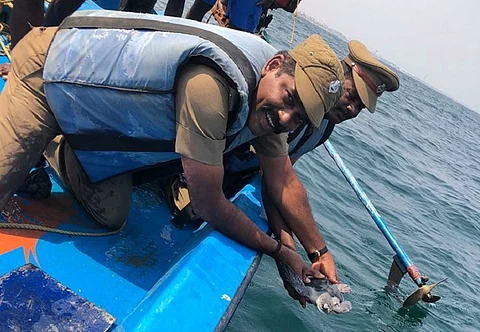

When forest officials in Chennai first brought a severely injured juvenile olive ridley turtle to the Besant Memorial Animal Dispensary in February, volunteers were highly skeptical of its chances of survival.
Spotted first near Ennore, locals who identified the endangered species immediately alerted forest officials. The sighting of a juvenile turtle is considered extremely rare even amongst conservationists. Infact, the adolescence period of a turtle is said to be its 'lost years' as it is hard to track it down during this time. When this particular turtle which was injured by a fishing net washed up to the shore, forest officials knew they had to act fast. They could have taken it to the zoo where experts and infrastructure to treat wildlife were already in place. However, to give this turtle a chance to survive, they had to keep it close to the sea as it had to be placed in salt water constantly.
And that is how it made its way to the Besant Memorial Animal Dispensary where the Forest Department and volunteers from the Students Sea Turtle Conservation Network (SSTCN) monitored its progress.
"When it was first brought to the dispensary, there was a lot of muscle loss in its flipper. The turtle's left flipper had been entangled in a piece of fishing net and had a deep cut. It was only 20-25% functional. We were skeptical about its survival," says Shravan Krishnan who volunteers with SSTCN. Estimating the baby turtle to be between 3-5 years old, Shravan said "We had worked with adult olive ridleys but this was the first time we were helping rehabilitate a juvenile turtle."
A wildlife veterinarian stitched up the flipper, but ensuring that the turtle made a full recovery was important. The team consulted experts in Maldives who have been studying sea turtles to understand the conditions it had to be kept under. "It was a lot of work," says Shravan. "We had to constantly monitor its weight, lift buckets of sea water which had to be changed twice a day. We fed the turtle only fish and prawns," he explains.
The turtle was kept in a tank and constantly monitored by the forest department as well. A week ago, the team decided to check if it can be released into the sea again.
They took the turtle to Kovalam where they observed the functionality of its flipper. "We were really happy. We placed it in five feet of water and it swam over 100 metres. It is important that the turtle be able to dive, which it did. One of our concerns was that it would lose its instincts if we kept in the dispensary for too long," says Shravan.
Satisfied by its progress, volunteers and the forest department decided it was time to send the baby turtle back to where it belongs. But for this, they had to first convince local fishermen to take the juvenile turtle with them to sea.
"Fishermen are scared to take turtles on their boat because it is considered an ill omen. But several members of the community from Urur Kuppam work closely with us in our conservation efforts, so they agreed to take the turtle," said Shravan. "So we took it out to sea and released it. It swam without any problem. "